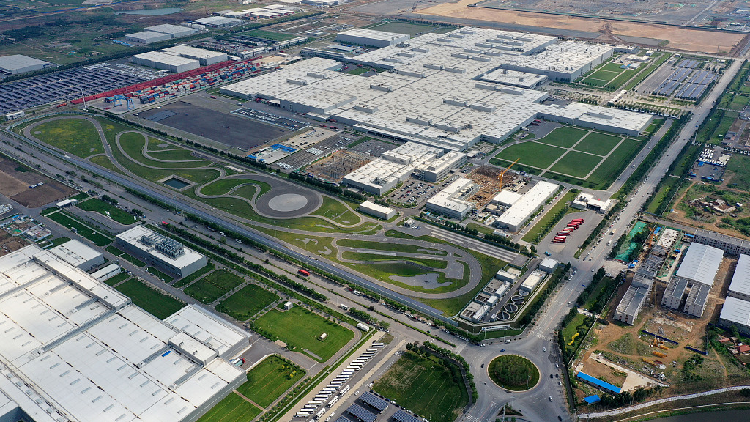
An art creation made up of living plants of different colors in a paddy field in Tai'an County of Anshan City, northeast China's Liaoning Province, September 9, 2023. /Xinhua
An art creation made up of living plants of different colors in a paddy field in Tai'an County of Anshan City, northeast China's Liaoning Province, September 9, 2023. /Xinhua
Editor's note: Liu Chunsheng, a special commentator on current affairs for CGTN, is an associate professor at the Beijing-based Central University of Finance and Economics. The article reflects the author's opinion, and not necessarily the views of CGTN.
China's northeast region, comprising the provinces of Liaoning, Jilin, and Heilongjiang, has been an integral part of the country's industrial backbone for decades. However, in recent years, the region has faced economic challenges, including declining heavy industries and a shrinking population. To address these issues and revitalize the region's economy, China's central government has introduced a comprehensive reform plan, which is poised to have far-reaching implications for the entire nation.
The revitalization of China's northeast region has been a long-standing priority for the government, but the new reforms signify a renewed commitment to this endeavor. The plan is multifaceted and addresses various aspects of the region's economy and society. One of the key elements is industrial transformation.
Historically, the northeast has been heavily reliant on traditionally heavy industries like coal, steel, and manufacturing. These sectors have faced overcapacity issues and environmental degradation, leading to a decline in economic vitality. Under the reform plan, the region is actively encouraged to upgrade its industrial base. This involves shifting towards high-tech industries, green manufacturing, and the service sector. By doing so, the region can reduce its dependence on polluting industries and foster sustainable economic growth.
The government is offering substantial support for this industrial transformation. Financial incentives, preferential policies, and investments in research and development are being provided to attract businesses and stimulate innovation. This approach aligns with China's broader goal of becoming a global leader in cutting-edge technologies and innovation, and the northeast can play a crucial role in achieving this ambition.
Another significant aspect of the reform plan is the improvement of infrastructure. To enhance connectivity within the region and with other parts of China, extensive investments are being made in transportation networks. This includes the development of high-speed rail lines, modernization of highways, and upgrades to ports and airports. These improvements not only facilitate the movement of goods but also boost the attractiveness of the northeast for investors and businesses looking for logistical advantages.
Furthermore, the plan emphasizes environmental protection and sustainable development. The northeast has grappled with pollution problems due to its heavy industrial base. To combat this, the reform package includes strict environmental regulations and the closure of highly polluting factories. Simultaneously, investments in green energy projects and eco-friendly technologies are being promoted, aligning with China's commitment to environmental sustainability.
Crucially, the government is also focusing on improving the quality of life for residents in the northeast. This includes investments in healthcare, education, and social services. Efforts to retain and attract talent are underway, as a skilled workforce is essential for the success of high-tech industries and innovation-driven development.

A production center of BMW in Shenyang, northeast China's Liaoning Province, June 2, 2020. /CFP
A production center of BMW in Shenyang, northeast China's Liaoning Province, June 2, 2020. /CFP
The plan's success relies heavily on the cooperation and engagement of local governments and businesses in the northeast. The region's authorities must embrace the reforms, streamline bureaucratic processes, and create a favorable business environment. Furthermore, collaboration with private enterprises, both domestic and international, will play a pivotal role in driving economic growth and technological advancement.
In addition to domestic efforts, international cooperation is also crucial for the northeast's revival. The Chinese government has been proactive in establishing special economic zones and trade corridors to enhance connectivity and economic ties with neighboring countries. Such cross-border initiatives have the potential to boost economic growth in the northeast.
The revitalization of the northeast region is not only essential for the area's residents but also carries significant national implications. A prosperous and innovative northeast contributes to China's economic resilience and global competitiveness. By upgrading its industrial base, embracing green technologies, and fostering a skilled workforce, the northeast can become a model for sustainable economic development.
However, challenges remain on this path to revitalization. The transformation of heavy industries into high-tech sectors requires time and substantial investments. Ensuring environmental protection while driving economic growth can be a delicate balancing act. And retaining and attracting talent in a region with an aging population and outmigration trends is no easy feat.
The northeast region is an important industrial and agricultural base for China. Maintaining its strategic importance for national defense, food security, ecological security, energy security, and industrial security is of great significance and is closely related to the overall development of the nation. The comprehensive reform plan aimed at revitalizing China's northeast region is a significant step towards addressing economic challenges and promoting sustainable growth. The multi-pronged approach, encompassing industrial transformation, infrastructure development, environmental protection, and social improvements, demonstrates the government's commitment to the region's prosperity.
The success of these reforms will hinge on effective implementation, cooperation with local governments and businesses, and the ability to adapt to changing circumstances. If executed well, the revitalization of the northeast can serve as a blueprint for other regions in China and demonstrate the nation's determination to modernize its economy while safeguarding its environment and improving the lives of its residents.
(If you want to contribute and have specific expertise, please contact us at opinions@cgtn.com. Follow @thouse_opinions on Twitter to discover the latest commentaries in the CGTN Opinion Section.)